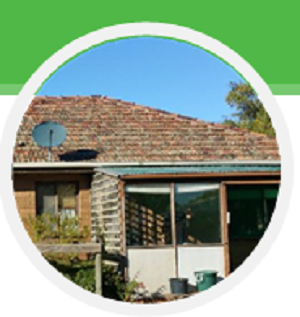THE HOME:
This home belongs to a three person family: Dawn, David and Linden. Their triple fronted brick veneer home with a tiled roof is very typical of 1960s. There are eaves all the way around the home and a pergola to the north west. 
The living room is on the south side so it is cooler for summer. Dawn is in the living room most of the time, sitting in the chair she loves with all her special things about her. There is evaporative cooling with six outlets that keep the living room cool when the humidity is low. However, in high humidity, the evaporative cooler is not effective. The kitchen is on the north western side of the home with large windows on both external walls.
All three bedrooms are on the east side, so they get the morning sun and they don’t heat up in the afternoon. They are protected to an extent by blow in wool insulation and fibreglass batts in their ceiling and, on the positive side, the north east facing main bedroom retains the heat in the winter. But in summertime, once the whole house gets hot, it gets really hot with its brick walls holding the heat all day and all night, giving the family no reprieve from those uncomfortable and sometimes dangerous temperatures.
THE CHALLENGES:
The kitchen is easily the hottest room; it has an external pergola with a green tinted roof. Due to its construction it retains the heat building up underneath it and pushes that heat directly into the kitchen. The evaporative cooler is the furthest away from the kitchen, so the kitchen does not get any cooling benefit at all.
“… it takes a while for the house to get hot, but once it does, it gets really hot.”
Because of the type of gas heating in the home, it was not possible to thoroughly draught proof the home, this is because in order to operate gas heating safely, you must have a source of ventilation available.
The type of insulation in this home allows it to have a cooler start at the beginning of a heatwave but once it gets hot, it unfortunately it also traps the heat inside. Some draught proofing been attempted by the family in the past but it was not effective at all.
THE SOLUTIONS:
To ensure the safety of Dawn and her family, who will continue to use their gas heating in winter, the ecoMaster team’s focus was on shading and zoning out hot areas. To significantly reduce the heat in the kitchen, reflective screens were installed on both windows as well as in the laundry and under the external covered pergola. In addition two external blinds were installed to reduce the direct sun strike on the home.
ecoMaster fitted perimeter seals to the front door, zoned off wet areas from the rest of the home (such as the bathroom and the toilet), adjusted the back door draught seal so that it worked properly, sealed wall vents and treated gaps and cracks that were at a safe distance from the family’s gas heating.

Leave a Reply